The high point of mediaeval glassmaking in the Bohemian Lands was reached during the reign of the last of the Luxembourgs-that is, under Charles IV (1346-1378) and Wenceslas IV (1378-1419). After the subsequent deep social crisis that had its origin in the Hussite revolution, the sorry plight of the country was not resolved until the Jagiellonian dynasty came to power (1471-1526). Many glassworks then emerged in the Bohemian Lands, producing a wide variety of hollowware (utility glass - beakers, goblets/flute-shaped beakers, bottles, “kuttrolfs”, etc.). These were made of “forest glass” with a greenish or brownish tint and were decorated with hot shaped applied ornament (prunts) or optical decor (moulded). Sheet glass was manufactured as well as hollowware, in connection with the great construction activity of the Middle Ages. The windows of mediaeval religious buildings were mainly glazed with coloured glass.
- Calendar
- Online Ticket Sales
- Access
- JA
- EN
The Radiance of Stillness and Motion: Bohemian Glass
from the Collection of the Museum of Decorative Arts in Prague
August 2 to September 28 2014
*There will be an exhibition change during the course of exhibition
Ⅰ:Late Middle Ages: 14th-15th century
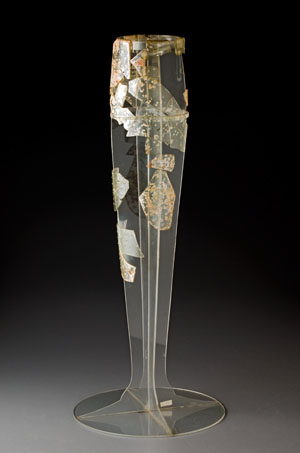
Flute-shaped Beaker [reconstruction]
c. 1400
Bohemia
Ⅱ:The Renaissance and Mannerism: c. 1550-1650
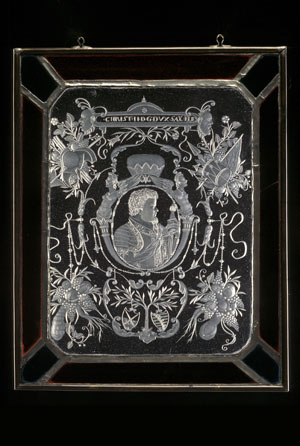
Panel with Engraved Portrait of Elector Christian II of Saxony
1602 or 1606
Casper Lehmann(engraving)/Prague or Dresden(glass)
A fresh impulse for the evolution of the craft of glassmaking in the Bohemian Lands came at the beginning of the 16th century with the arrival of leading glassmaking families from neighbouring Saxony. They established glassworks particularly in the border regions, abundant in forests and raw materials. Through the first half of the 16th century, the glassmakers continued working in the mediaeval tradition. Around the mid-16th century, the morphology of the items began to evolve, with a change in the repertoire of products. Renaissance goblets begin to appear, small and large beakers in funnel and cylindrical shapes, pitchers, jugs, pilgrimage bottles and so on. The main decorative techniques were optical decor and hot shaping. Glass was also decorated with painting in bright enamels and engraving; the first in Prague to use this technique (on glass) was Caspar Lehmann (1563 or 1565-1622), court engraver to Rudolf II Habsburg (1575-1612), in whose reign Prague became a major European cultural centre.
Ⅲ:Baroque and Rococo: c. 1650-1790
In the first half of the 17th century, the manufacture of hollowware in the Bohemian Lands followed the pattern of Late Renaissance production. Optical decor and embedded, hot shaped decorative elements continued to be used. At this time luxury glass indebted to the Venetian style began to be manufactured alongside ordinary utility glass. A significant shift in the production of Baroque glass took place in the 1770s when colourless, potassium-lime glass known as Bohemian crystal began to be manufactured. A number of different shapes were used during this period. Goblets with tall articulated stems decorated with shallow engraving were manufactured along with beakers, bottles, “humpen” (painted with enamels) etc.. The apogee of Bohemian glassmaking in the Baroque period came in the first half of the 18th century, thanks to the expansion of production of high quality colourless hollowware on which abundant use of cutting and engraving became dominant as a decorative technique. The border regions remained the main centres of production, with the glassworks manufacturing coloured glass (cobalt and ruby, for example) alongside clear glass. Light blue glass appears in the second half of the 18th century, and even opaque white (milk) glass. The baluster goblet held a prime position among manufactured items; there were also sweetmeat dishes, cone-shaped beakers, bottles, jugs, pitchers, etc.. The region of Silesia held a unique position around 1700, when it was the source of items decorated in the cameo gravure technique (relief engraving). In addition to engraving, items were painted in bright enamels, schwarzlot and gold. Rococo painting appears from the mid-18th century, often copying the form and themes of European porcelain of the time. In the first quarter of the 18th century, double-walled glasses (Zwischengoldglaser - decoration in gold leaf between two glass casings) were manufactured in the Bohemian Lands, uniquely in Central Europe.
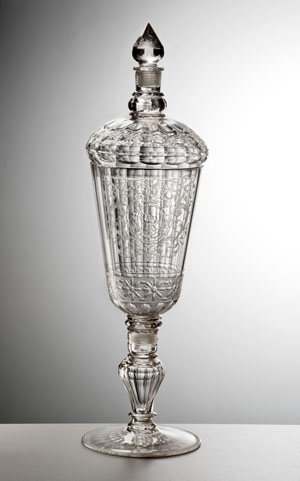
Covered Goblet with the Engraved Kolowrat Coat of Arms
c. 1720
Bohemia
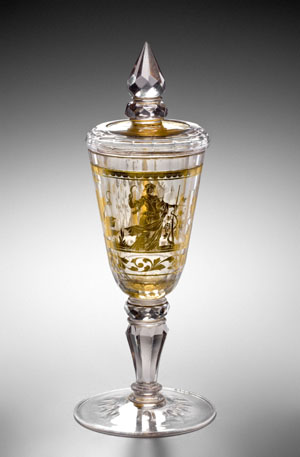
Double-walled Covered Goblet with Allegory of the Four Seasons
1730-40
Bohemia
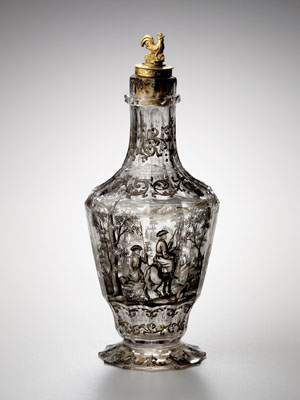
Bottle with Painted Hunting Scene
1725-30
Workshop Daniel and Ignaz Preissler (painting)/Bohemia (glass)
Ⅳ:Classicism, Empire, Biedermeier, Rococo Revival: The first half of the 19th century-c. 1865
As its simple, untroubled shapes testify, Classicist (Empire) glass from the beginning of the 19th century was, like other spheres of the visual arts, influenced by admiration for the Ancient World. Colourless glass predominated, decorated mainly with subtle ornamental or figural engraving. From the end of the 1820s, a new trend appeared - Biedermeier - when coloured glass began to predominate. There was also a change in the morphology of drinking and decorative glass, which appears in countless variants of the brilliant (diamond) cut and stereometric principles. Decoration was a combination of cutting, engraving and in some cases painting. The same was true of the Rococo Revival, with the difference that there was a certain simplification of shapes. The main centres for manufacture and decoration were found in northern and southern Bohemia. At the same time, many artists (especially glass engravers) worked during the season in the west Bohemian spa towns. The best known is Dominik Biemann (1800-1857), famous for his excellent portraits. In the 1820s, 1830s and 1840s, new kinds of molten glass were invented and procedures upgraded. Count Buquoy (1781-1851) developed black and red hyalith glass, Josef Riedel was the first to smelt greenish-yellow uranium glass, and Friedrich Egermann (1777-1864) devoted himself to the production of stained and marbled (lythyalin) glass. The glassworks of Count Harrach was the first in Central Europe to master the technology of embedding porcelain paste in glass.
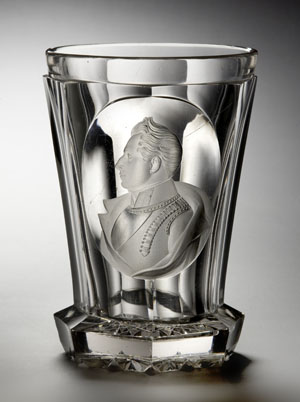
Beaker with Engraved Portrait of a Man
Before 1830
Dominik Biemann (engraving)/ Harrach Glassworks
in Novy Svet [Neuwelt](glass and cutting)
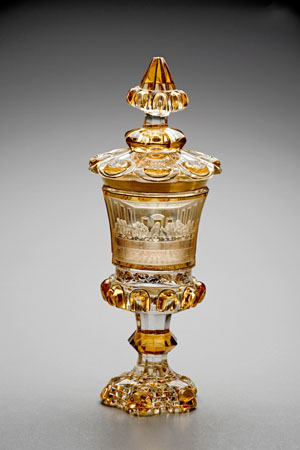
c. 1840
North Bohemia (engraving and painting)/Harrach Glassworks
in Novy Svet [Neuwelt](glass and cutting)
Ⅴ:Historicism: c. 1860-1890
At the beginning of the second half of the 19th century, reforms took place in Western Europe (especially in England) whose aim was the restoration of the quality of arts and crafts. These were based on inspiration from historical artistic styles. In the Bohemian Lands and Austro-Hungary as a whole, a crucial role was played by the glass entrepreneur and artist Ludwig Lobmeyr (1829-1917), who produced luxury glass in the Neo-Renaissance style in cooperation with leading Austrian artists. Later (in the 1870s) art from the Orient (the Near East) served as inspiration for his products. The professional glassworks schools in Kamenicky Senov (Steinschonau, founded 1856) and (Novy) Bor (Haida, founded 1870) in northern Bohemia played an important role in the development of glassmaking at this time. In addition to Lobmeyr the glassworks of Count Harrach, Josef Riedl and Wilhelm Kralik produced high quality glass. Another important operative centre of glass was in the west Bohemian spa Karlovy Vary (Karlsbad), where Ludwig Moser (1833-1916) had his decorating shop that embellished glass at first by engraving, and later by painting in the Arabian and Japanese styles.
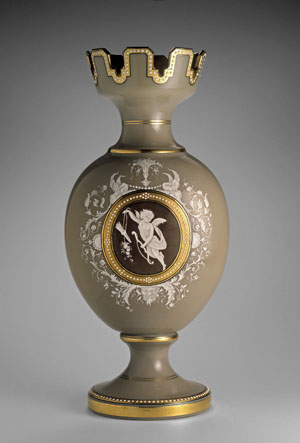
Vase with Painting Emulating Cameo
1876
Harrach Glassworks in Novy Svet [Neuwelt]
Ⅵ:Art Nouveau, Art Deco, Functionalism: c. 1890-World War II
The 20th century was a time of expansion of glass production, but also a time of many economic, social and cultural reversals caused by political events at home and abroad, under whose influence both industry and glass art were transformed. At the turn of the 19th and 20th century products in the style of the Secession came into fashion. This involved the whole sphere of applied art, including glass. The shapes of glass vases were set in motion and their surfaces covered with a lively decor of flowers and the stems of plants. The firm of Lotz gained a high reputation among Bohemian manufacturers. Professional artists working with the glassworks came increasingly to the fore. The manufacturing and sales cooperative Artel came into existence in 1908 with the aim of improving the quality of workshop production of utility and decorative items. Art glass prospered after 1918 in the newly founded Czechoslovak Republic, when works with a specific colourfulness and morphology in the spirit of Art Deco appeared and then, from the end of the 1920s, Functionalist utility items for daily use. At the beginning of the 1920s, Josef Drahonovsky at the Academy of Applied Arts established official courses for glass artists. In 1920 a glassmaking school was set up to support local production in Zelezny Brod, a centre of modern glass art.
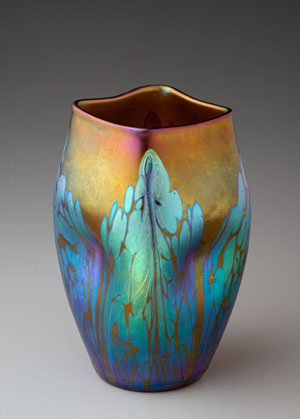
Vase
1902
Johann Lotz Widow [Witwe] Glassworks, KlaStersky Mlyn [Klostermuhle] (execution)
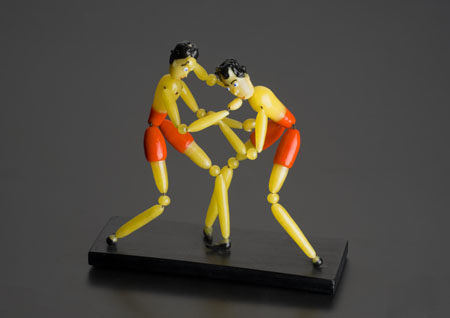
"Wrestlers"Figurine
c. 1925
Jaroslav Brychta (design)/ Glassmaking school, Zelezny Brod [Eisenbrod] (execution)
Ⅶ:Bohemian Glass from 1945 to the Present
After 1945, Czech artists defined their main task as the creation of a completely new form of glassmaking. The phenomenon of “studio art” emerged, an art in which the Czech artists often played a leading role internationally. They experimented with the use of glass in sculpture and painting and handled this material in a very original way. They expressed themselves in abstract art, and were inspired by the human form, technology, nature and often the beauty of the glass material itself. One of the greatest contributions to glass art worldwide was the development of mould-melted glass technology, made famous by Stanislav Libensky and Jaroslava Brychtova. Participation in international exhibitions such as EXPO 58 in Brussels, EXPO 67 in Montreal and EXPO 70 in Osaka helped towards the success of Czech glass worldwide. The standard of Czech glass was crucially influenced by the structured system of education in glassmaking headed by the Academy of Applied Art in Prague. At the present time, art glass is still evolving, it abounds in creative ideas and impeccable craftsmanship. Czech glassworks are visited by highly skilled craftsmen and artists literally from the whole world, working together to create highly sophisticated art works in glass. The story of Czech glass has brought many exciting twists and turns, in the course of which glassmaking craftsmen, technologists, artists, teachers, entrepreneurs and businessmen have always managed to find a creative starting point leading to its continuation.
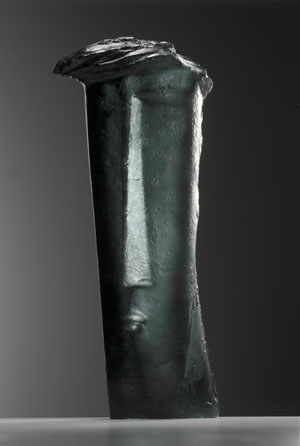
Head I
1958-59
Stanislav Libensky and Jaroslava Brychtova (design)/
Zeleznobrodske glassworks, Zelezny Brod (execution)
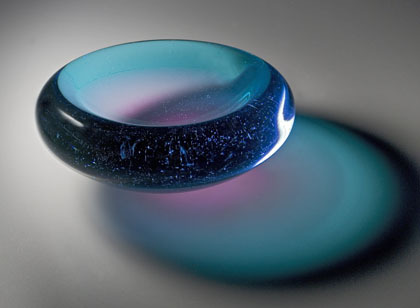
Heart Chakra
2007
Pavel Trnka
*Unauthorized reproduction or use of texts or images from this site is prohibited.
2024 January
- Exhibition
- Closed
- Tea Ceremony
- Mon
- Tue
- Wed
- Thu
- Fri
- Sat
- Sun
- 1
- 2
- 3
- 4
- 5
- 6
- 7
- 8
- 9
- 10
- 11
- 12
- 13
- 14
- 15
- 16
- 17
- 18
- 19
- 20
- 21
- 22
- 23
- 24
- 25
- 26
- 27
- 28
- 29
- 30
- 31
2024 February
- Exhibition
- Closed
- Tea Ceremony
- Mon
- Tue
- Wed
- Thu
- Fri
- Sat
- Sun
- 1
- 2
- 3
- 4
- 5
- 6
- 7
- 8
- 9
- 10
- 11
- 12
- 13
- 14
- 15
- 16
- 17
- 18
- 19
- 20
- 21
- 22
- 23
- 24
- 25
- 26
- 27
- 28
- 29
2024 March
- Exhibition
- Closed
- Tea Ceremony
- Mon
- Tue
- Wed
- Thu
- Fri
- Sat
- Sun
- 1
- 2
- 3
- 4
- 5
- 6
- 7
- 8
- 9
- 10
- 11
- 12
- 13
- 14
- 15
- 16
- 17
- 18
- 19
- 20
- 21
- 22
- 23
- 24
- 25
- 26
- 27
- 28
- 29
- 30
- 31
2024 April
- Exhibition
- Closed
- Tea Ceremony
- Mon
- Tue
- Wed
- Thu
- Fri
- Sat
- Sun
- 1
- 2
- 3
- 4
- 5
- 6
- 7
- 8
- 9
- 10
- 11
- 12
- 13
- 14
- 15
- 16
- 17
- 18
- 19
- 20
- 21
- 22
- 23
- 24
- 25
- 26
- 27
- 28
- 29
- 30
2024 May
- Exhibition
- Closed
- Tea Ceremony
- Mon
- Tue
- Wed
- Thu
- Fri
- Sat
- Sun
- 1
- 2
- 3
- 4
- 5
- 6
- 7
- 8
- 9
- 10
- 11
- 12
- 13
- 14
- 15
- 16
- 17
- 18
- 19
- 20
- 21
- 22
- 23
- 24
- 25
- 26
- 27
- 28
- 29
- 30
- 31
2024 June
- Exhibition
- Closed
- Tea Ceremony
- Mon
- Tue
- Wed
- Thu
- Fri
- Sat
- Sun
- 1
- 2
- 3
- 4
- 5
- 6
- 7
- 8
- 9
- 10
- 11
- 12
- 13
- 14
- 15
- 16
- 17
- 18
- 19
- 20
- 21
- 22
- 23
- 24
- 25
- 26
- 27
- 28
- 29
- 30
2024 July
- Exhibition
- Closed
- Tea Ceremony
- Mon
- Tue
- Wed
- Thu
- Fri
- Sat
- Sun
- 1
- 2
- 3
- 4
- 5
- 6
- 7
- 8
- 9
- 10
- 11
- 12
- 13
- 14
- 15
- 16
- 17
- 18
- 19
- 20
- 21
- 22
- 23
- 24
- 25
- 26
- 27
- 28
- 29
- 30
- 31
2024 August
- Exhibition
- Closed
- Tea Ceremony
- Mon
- Tue
- Wed
- Thu
- Fri
- Sat
- Sun
- 1
- 2
- 3
- 4
- 5
- 6
- 7
- 8
- 9
- 10
- 11
- 12
- 13
- 14
- 15
- 16
- 17
- 18
- 19
- 20
- 21
- 22
- 23
- 24
- 25
- 26
- 27
- 28
- 29
- 30
- 31
2024 September
- Exhibition
- Closed
- Tea Ceremony
- Mon
- Tue
- Wed
- Thu
- Fri
- Sat
- Sun
- 1
- 2
- 3
- 4
- 5
- 6
- 7
- 8
- 9
- 10
- 11
- 12
- 13
- 14
- 15
- 16
- 17
- 18
- 19
- 20
- 21
- 22
- 23
- 24
- 25
- 26
- 27
- 28
- 29
- 30
2024 October
- Exhibition
- Closed
- Tea Ceremony
- Mon
- Tue
- Wed
- Thu
- Fri
- Sat
- Sun
- 1
- 2
- 3
- 4
- 5
- 6
- 7
- 8
- 9
- 10
- 11
- 12
- 13
- 14
- 15
- 16
- 17
- 18
- 19
- 20
- 21
- 22
- 23
- 24
- 25
- 26
- 27
- 28
- 29
- 30
- 31
2024 November
- Exhibition
- Closed
- Tea Ceremony
- Mon
- Tue
- Wed
- Thu
- Fri
- Sat
- Sun
- 1
- 2
- 3
- 4
- 5
- 6
- 7
- 8
- 9
- 10
- 11
- 12
- 13
- 14
- 15
- 16
- 17
- 18
- 19
- 20
- 21
- 22
- 23
- 24
- 25
- 26
- 27
- 28
- 29
- 30
2024 December
- Exhibition
- Closed
- Tea Ceremony
- Mon
- Tue
- Wed
- Thu
- Fri
- Sat
- Sun
- 1
- 2
- 3
- 4
- 5
- 6
- 7
- 8
- 9
- 10
- 11
- 12
- 13
- 14
- 15
- 16
- 17
- 18
- 19
- 20
- 21
- 22
- 23
- 24
- 25
- 26
- 27
- 28
- 29
- 30
- 31
2025 January
- Exhibition
- Closed
- Tea Ceremony
- Mon
- Tue
- Wed
- Thu
- Fri
- Sat
- Sun
- 1
- 2
- 3
- 4
- 5
- 6
- 7
- 8
- 9
- 10
- 11
- 12
- 13
- 14
- 15
- 16
- 17
- 18
- 19
- 20
- 21
- 22
- 23
- 24
- 25
- 26
- 27
- 28
- 29
- 30
- 31
2025 February
- Exhibition
- Closed
- Tea Ceremony
- Mon
- Tue
- Wed
- Thu
- Fri
- Sat
- Sun
- 1
- 2
- 3
- 4
- 5
- 6
- 7
- 8
- 9
- 10
- 11
- 12
- 13
- 14
- 15
- 16
- 17
- 18
- 19
- 20
- 21
- 22
- 23
- 24
- 25
- 26
- 27
- 28
2025 March
- Exhibition
- Closed
- Tea Ceremony
- Mon
- Tue
- Wed
- Thu
- Fri
- Sat
- Sun
- 1
- 2
- 3
- 4
- 5
- 6
- 7
- 8
- 9
- 10
- 11
- 12
- 13
- 14
- 15
- 16
- 17
- 18
- 19
- 20
- 21
- 22
- 23
- 24
- 25
- 26
- 27
- 28
- 29
- 30
- 31
2025 April
- Exhibition
- Closed
- Tea Ceremony
- Mon
- Tue
- Wed
- Thu
- Fri
- Sat
- Sun
- 1
- 2
- 3
- 4
- 5
- 6
- 7
- 8
- 9
- 10
- 11
- 12
- 13
- 14
- 15
- 16
- 17
- 18
- 19
- 20
- 21
- 22
- 23
- 24
- 25
- 26
- 27
- 28
- 29
- 30
2025 May
- Exhibition
- Closed
- Tea Ceremony
- Mon
- Tue
- Wed
- Thu
- Fri
- Sat
- Sun
- 1
- 2
- 3
- 4
- 5
- 6
- 7
- 8
- 9
- 10
- 11
- 12
- 13
- 14
- 15
- 16
- 17
- 18
- 19
- 20
- 21
- 22
- 23
- 24
- 25
- 26
- 27
- 28
- 29
- 30
- 31
2025 June
- Exhibition
- Closed
- Tea Ceremony
- Mon
- Tue
- Wed
- Thu
- Fri
- Sat
- Sun
- 1
- 2
- 3
- 4
- 5
- 6
- 7
- 8
- 9
- 10
- 11
- 12
- 13
- 14
- 15
- 16
- 17
- 18
- 19
- 20
- 21
- 22
- 23
- 24
- 25
- 26
- 27
- 28
- 29
- 30
2025 July
- Exhibition
- Closed
- Tea Ceremony
- Mon
- Tue
- Wed
- Thu
- Fri
- Sat
- Sun
- 1
- 2
- 3
- 4
- 5
- 6
- 7
- 8
- 9
- 10
- 11
- 12
- 13
- 14
- 15
- 16
- 17
- 18
- 19
- 20
- 21
- 22
- 23
- 24
- 25
- 26
- 27
- 28
- 29
- 30
- 31
2025 August
- Exhibition
- Closed
- Tea Ceremony
- Mon
- Tue
- Wed
- Thu
- Fri
- Sat
- Sun
- 1
- 2
- 3
- 4
- 5
- 6
- 7
- 8
- 9
- 10
- 11
- 12
- 13
- 14
- 15
- 16
- 17
- 18
- 19
- 20
- 21
- 22
- 23
- 24
- 25
- 26
- 27
- 28
- 29
- 30
- 31
2025 September
- Exhibition
- Closed
- Tea Ceremony
- Mon
- Tue
- Wed
- Thu
- Fri
- Sat
- Sun
- 1
- 2
- 3
- 4
- 5
- 6
- 7
- 8
- 9
- 10
- 11
- 12
- 13
- 14
- 15
- 16
- 17
- 18
- 19
- 20
- 21
- 22
- 23
- 24
- 25
- 26
- 27
- 28
- 29
- 30
2025 October
- Exhibition
- Closed
- Tea Ceremony
- Mon
- Tue
- Wed
- Thu
- Fri
- Sat
- Sun
- 1
- 2
- 3
- 4
- 5
- 6
- 7
- 8
- 9
- 10
- 11
- 12
- 13
- 14
- 15
- 16
- 17
- 18
- 19
- 20
- 21
- 22
- 23
- 24
- 25
- 26
- 27
- 28
- 29
- 30
- 31
2025 November
- Exhibition
- Closed
- Tea Ceremony
- Mon
- Tue
- Wed
- Thu
- Fri
- Sat
- Sun
- 1
- 2
- 3
- 4
- 5
- 6
- 7
- 8
- 9
- 10
- 11
- 12
- 13
- 14
- 15
- 16
- 17
- 18
- 19
- 20
- 21
- 22
- 23
- 24
- 25
- 26
- 27
- 28
- 29
- 30
2025 December
- Exhibition
- Closed
- Tea Ceremony
- Mon
- Tue
- Wed
- Thu
- Fri
- Sat
- Sun
- 1
- 2
- 3
- 4
- 5
- 6
- 7
- 8
- 9
- 10
- 11
- 12
- 13
- 14
- 15
- 16
- 17
- 18
- 19
- 20
- 21
- 22
- 23
- 24
- 25
- 26
- 27
- 28
- 29
- 30
- 31
